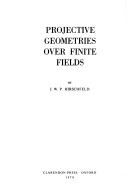Oxford Mathematical Monographs Oxford Science Publications
1 total work
This book is an account of the combinatorics of projective spaces over a finite field, with special emphasis on one and two dimensions. With its successor volumes, Finite projective spaces over three dimensions (1985), which is devoted to three dimensions, and General Galois geometries (1991), on a general dimension, it provides a comprehensive treatise of this area of mathematics. The area is interesting in itself, but is important for its
applications to coding theory and statistics, and its use of group theory, algebraic geometry, and number theory. This edition is a complete reworking of the first edition. The chapters bear almost the same titles as the first edition, but every chapter has been changed. The most significant changes are to Chapters 2, 10,
12, 13, which respectively describe generalities, the geometry of arcs in ovals, the geometry of arcs of higher degree, and blocking sets. The book is divided into three parts. The first part comprises two chapters, the first of which is a survey of finite fields; the second outlines the fundamental properties of projective spaces and their automorphisms, as well as properties of algebraic varieties and curves, in particular, that are used in the rest of the book and the accompanying two
volumes. Parts II and III are entirely self-contained; all proofs of results are given. The second part comprises Chapters 3 to 5. They cover, in an arbitrary dimension, the properties of subspaces such as their number and characterization, of partitions into both subspaces and subgeometries, and of
quadrics and Hermitian varieties, as well as polarities. Part III is a detailed account of the line and the plane. In the plane, fundamental properties are first revisited without much resort to the generalities of Parts I and II. Then, the structure of arcs and their relation to curves is described; this includes arcs both of degree two and higher degrees. There are further chapters on blocking sets and on small planes, which means of orders up to thirteen. A comprehensive bibliography of
more than 3000 items is provided. At the end of each chapter is a section, Notes and References, which attributes proofs, includes further comments, and lists every relevant reference from the bibliography.
applications to coding theory and statistics, and its use of group theory, algebraic geometry, and number theory. This edition is a complete reworking of the first edition. The chapters bear almost the same titles as the first edition, but every chapter has been changed. The most significant changes are to Chapters 2, 10,
12, 13, which respectively describe generalities, the geometry of arcs in ovals, the geometry of arcs of higher degree, and blocking sets. The book is divided into three parts. The first part comprises two chapters, the first of which is a survey of finite fields; the second outlines the fundamental properties of projective spaces and their automorphisms, as well as properties of algebraic varieties and curves, in particular, that are used in the rest of the book and the accompanying two
volumes. Parts II and III are entirely self-contained; all proofs of results are given. The second part comprises Chapters 3 to 5. They cover, in an arbitrary dimension, the properties of subspaces such as their number and characterization, of partitions into both subspaces and subgeometries, and of
quadrics and Hermitian varieties, as well as polarities. Part III is a detailed account of the line and the plane. In the plane, fundamental properties are first revisited without much resort to the generalities of Parts I and II. Then, the structure of arcs and their relation to curves is described; this includes arcs both of degree two and higher degrees. There are further chapters on blocking sets and on small planes, which means of orders up to thirteen. A comprehensive bibliography of
more than 3000 items is provided. At the end of each chapter is a section, Notes and References, which attributes proofs, includes further comments, and lists every relevant reference from the bibliography.
